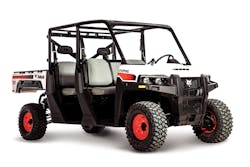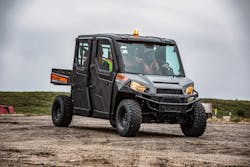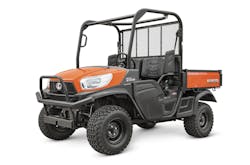Compact utility vehicles (UTVs) have evolved from a mode of worker transport into a machine that can haul and tow a sizable payload.
Manufacturers have answered the rising demand for such applications with enhancements to vehicle durability and updates to technology. UTVs have also begun to adopt pickup components, providing managers with the potential to replace trucks on work sites.
“In the past, UTVs were primarily recreational, or used on farming applications,” says Amy Vincent, Caterpillar product specialist. “Nowadays customers want a UTV that can withstand the ruggedness of a work site. They’re looking at the quality of the machine, how long it’s going to last, and are ensuring things aren’t going to break.”
With more equipment managers looking to use UTVs for heavy lifting and material transport, manufacturers have begun to implement durability-focused features. Caterpillar’s full-length skid plate, for example—essentially a hard piece of plastic—covers the entire underbelly of the machine. It protects the drivetrain and undercarriage from potential impact.
“You want to make sure that underbelly is strong,” Vincent says. “As you’re going over rough terrain, you have things that would conflict with the bottom, so [the skid plate] helps protect those internal components.”
What safety features are on UTVs?
“Nowadays there has been a lot more thought around safety,” Vincent says. “On our five-seat machine, we have a seat belt for every seat that you have. Even if you upgrade that to the sixth seat, you have a three-point belt for every seat.”
Polaris uses orange seat belts to improve visibility on the Polaris Pro XD utility vehicle.
“We added orange belts because if you’re a job-site foreman and you’ve got a huge construction site, it’s a lot easier to see someone not wearing their seatbelts,” says Nick Snidarich, Polaris product management specialist.
Managers can also limit a Cat UTV’s speed electronically. On Caterpillar’s gas-powered UTVs, the top speed is 45 mph, though users can limit that to 25 mph and anywhere in between. The vehicle will not exceed 15 mph if the vehicle detects an unbuckled belt in the driver’s seat.
“In some cases, you may want the 45 miles per hour,” Vincent says. “If you’re on a highway job and you’ve got a lot of ground to cover, that would be beneficial. But in general, when you’re on the job site, there are a lot of people around. It would be best to lock that speed down from a safety perspective.”
Similarly, the Polaris Pro XD allows the owner to decrease the top speed to 15 mph.
“Job sites also have speed limits on their sites, and one of the highest you’ll see is 25 mph,” says Snidarich. “There are even some customers who want slower, so we also offer a 15 mph kit.”
In the past, managers were required to lock out machine speed using a seperate key. On Cat UTVs, the speed limiter can be adjusted via the machine’s interactive display.
“If the owner or the equipment foreman wants to make a speed adjustment, they’d use a password to lock it out,” Vincent says. “That way individual operators can’t turn up the speed.”
UTV manufacturers have also begun adopting “luxury” features from the automotive industry, according to Justin VanderHeyden, John Deere’s product marketing manager for UTVs. Since these components are now widely used in vehicles such as pickup trucks, Deere has seen an increase in availability.
“LCD components, for example, are mass produced now and are more readily available,” he says. “We can afford to put them in a utility vehicle and still have it be affordable.”
UTVs now offer LCD instrument clusters and panels, premium infotainment options, stereos, and subwoofers. Some also have cabs with heat and air conditioning.
“A lot of our customers are the ones buying the fully decked out pickup trucks,” VanderHeyden says. “They’re starting to expect the same ‘creature comforts’ and features in their UTVs.”
Last year, Deere launched the XUV835R and the XUV865R, two UTVs modeled after a pickup truck. These UTVs feature premium cloth interior, sun visors, LED headlights, LCD displays, heating, and air conditioning.
“We’re taking some of the things a customer may see in their truck and creating that experience in the cab of our utility vehicles,” he says.
Before UTVs began taking on pickup-like tasks, Vincent says this experience wasn’t as crucial.
“If it’s just being used to drive from point A to point B and workers are not in it very long, it’s not as important,” she says. “If it’s going to run eight hours a day, then you definitely want to think about the comfort. It’s cheaper to get a UTV with cab heat than it is to get a nice truck with the same features, plus you get some additional work-site versatility.”
Halogen headlights and rear lights are also being converted to LED bulbs. Since LEDs have higher lumens/ output, the light they emit is brighter than halogen bulbs. They also require less power from the UTV’s alternator, allowing users to power more attachments.
“We have some customers in Nevada who run our utility vehicles underground in the mines,” VanderHeyden says. “They want a lot of bright lights on the vehicle, both forward and rear-facing. You can run a lot of LED light bars on the machine, and the alternator can keep up with the demand of those lights.”
LEDs are also more durable, able to withstand rough terrain and environmental conditions more efficiently than halogen bulbs. VanderHeyden says Deere’s LED bulbs have an ingress protection rating (IP) of 69K, meaning they can be fully submerged in water without shorting out.
The IP of a bulb or fitting determines the level of protection it has against dirt and water. Any bulb that is to be used in a wet environment should have a high IP rating, whether it is used in mining or an alternative application.
“There are a lot of acidic-type liquids coming off the walls within mines,” he says. “These lights are fully sealed and able to withstand those environments underground.”
As the full potential of UTV innovation unfolds, the industry may begin to view them as the most viable vehicle option for heavy construction applications. Various upgrades to durability, safety, and comfort will continue to progress as demand increases.







